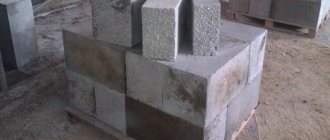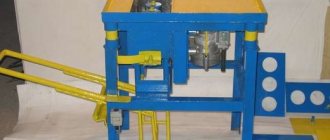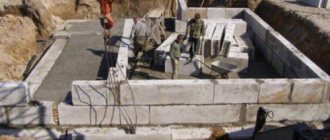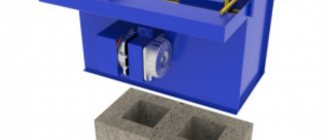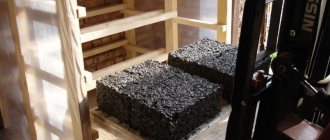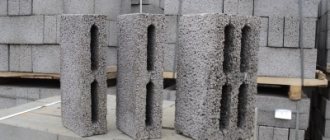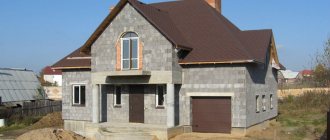- 1 Advantages and disadvantages of the material
- 2 Composition and proportions
- 3 What will you need for work?
- 4 Do-it-yourself manufacturing (technology)
- 5 Useful tips
- 6 Conclusion
Nowadays, many builders refuse to use traditional building materials, preferring new products created using modern technologies. This is not surprising, because thanks to new developments it is possible to build houses and other structures that are strong and durable. Moreover, the cost of such materials is often more affordable than the cost of traditional means. In particular, polystyrene concrete and expanded polystyrene concrete have become very popular today. Blocks from this material can be made at home. The production of polystyrene concrete blocks will save money on building materials.
Polystyrene concrete is one of the types of lightweight concrete mortars, which are presented in the form of a composite building material. The ingredients used in the preparation are granulated and polystyrene Portland cement.
Advantages and disadvantages of the material
Experts point out that polystyrene concrete blocks have more advantages than disadvantages. The benefits include:
- environmental safety;
- durability (service life is more than one hundred years);
- fire resistance (building material can withstand high temperatures for a long time);
- hydrophobicity;
- good thermal insulation characteristics;
- low thermal conductivity (a wall made of polystyrene concrete blocks 50 centimeters thick corresponds to brickwork more than one meter thick);
- soundproofing.
In addition, polystyrene concrete is easily processed by mechanical devices. Structures in the manufacture of which this building material was used can be drilled, sawed, milled and fastened with nails.
Polystyrene concrete composition is a universal building material that meets all requirements, however, it also has disadvantages. In particular, as practice has shown, after twenty cycles of freezing and thawing, the strength of concrete blocks decreases: they gradually crack and collapse.
Return to contents
Advantages
The advantages of polystyrene concrete products include the following points:
- Products made of polystyrene concrete do not require additional insulation with foam plastic or mineral wool, since they are characterized by high thermal insulation properties.
- Sound and heat insulation are included in the list of key advantages due to which people choose polystyrene concrete - the thermal conductivity of the material is quite low, since there are practically no seams when laying it. The declared sound insulation is 37 dB for a wall with a thickness of 100 mm. Connecting the elements requires the use of special glue.
- Processing the material is quite easy and comfortable. At the same time, independent production is characterized by low material consumption and reduces the need for solution by 70%.
- Installation work does not require special skills and is completed in a short time. Due to their low weight and dimensions, transportation, fastening and other actions with blocks are simplified.
- Improved resistance to negative environmental influences. The products are not afraid of moisture, freezing temperatures, mold or mildew.
- The service life of the material can exceed 100 years. Thanks to this advantage, it is very popular and is used in various spheres of human activity.
- Structures based on polystyrene concrete blocks meet modern standards of environmental, sanitary and hygienic safety.
- Processing the surfaces of products does not require special effort or skills.
Composition and proportions
Proportions of expanded polystyrene concrete for 1 m3.
The production of blocks is similar to the production of other building mixtures: in this case, it is also important to carefully adhere to the recipe and the order of work. In other words, the instructions should be followed as precisely as possible. In addition, it is necessary to take into account that polystyrene concrete, as well as other concrete solutions, is produced under different brands. Builders can produce mixtures with high thermal insulation properties, but with lower strength characteristics. And vice versa, a dense material, but with low thermal insulation. In this case, the manufacturing technology will depend on the purpose of polystyrene concrete.
Before starting construction work, you need to find out what proportions you need to adhere to in order to make a high-quality composition that is ideal for solving the construction tasks assigned to you. It is necessary that the production technology of polystyrene concrete be followed. At the same time, it is important for builders to use high-quality equipment for the production of polystyrene concrete.
The ratio of components (formulation per cubic meter) of different brands of mixtures, which experts tested in practice, making polystyrene concrete with their own hands:
- D200. To mix, you must adhere to the following recipe: 160 kilograms of cement (grade M400), polystyrene - one cubic meter, one hundred liters of water, one kilogram of SDO.
- D300. It is necessary to use 160 kilograms of M300 cement mixture, 75 kilograms of alluvial sand, as well as polystyrene - 9 kilograms, latex - 5 kilograms, water - 95 liters.
- D400. You will need 190 kilograms of M300 cement mixture, alluvial sand - 110 kilograms, polystyrene - 10 kilograms, latex - 4 kilograms, water - 115 liters.
- D500. To make polystyrene concrete with your own hands, you will need 215 kilograms of M300 cement mixture, alluvial sand - 180 kilograms, polystyrene - 11 kilograms, latex - 5 kilograms, water - 130 liters.
Experts also increase the strength of polystyrene concrete structures by adding special fibers to the compositions that are compatible with Portland cement. After hardening, special fibers will minimize microdeformations caused by temperature fluctuations and shrinkage when the composition hardens.
Return to contents
Plastering polystyrene concrete blocks
When finishing polystyrene concrete blocks, there are often no nuances or difficulties, but you need to know a few basic rules that should be followed when plastering walls:
- Polystyrene concrete has good adhesive properties, so the surface of the blocks will practically not absorb moisture from the plaster. The drying speed will be slightly higher than in the case of brick and aerated concrete.
- In order to plaster polystyrene concrete blocks with high quality, you need to use mixtures of a special elastic composition that could adapt to temperature fluctuations. This is due to the fact that polystyrene concrete is subject to linear expansion.
- In order for the mixture to spread as evenly as possible, it is applied to a previously wetted surface. This is the only way the plaster will not slide off the walls.
- For more effective attachment, plaster, both external and internal, must be reinforced. What are metal and nylon meshes used for?
What will you need for work?
You can mix the solution with a simple stirrer.
When carrying out the work, you will need equipment for the production of polystyrene concrete blocks. Experts use a concrete mixer for mixing. At the same time, you can do without equipment and use a simple mixer, the cost of which is quite reasonable. In addition, to prepare the solution you need a shovel. Before mixing the ingredients, you need to determine the required density of the concrete solution. You also need to carefully weigh all the components. It is important to remember that different polystyrene concrete mixtures have different densities. The solution requires water, cement of the required grade, PVG, and additives.
Return to contents
Required Tools
In order to prepare a solution of lightweight concrete at home, you will need the following tools:
- A concrete mixer, or any container in which you can mix it manually (with a garden shovel or hoe) or using a drill with a specialized attachment. Components for preparing the solution, according to the table. A bucket or shovel, with which you will measure the amount of components. Forms for block production. You can make them yourself, for example, by pinning old boards together and treating the inner surface of the resulting matrix with machine oil.
Do-it-yourself manufacturing (technology)
The technology for producing concrete mortar with the addition of polystyrene granules is not much different from the preparation of other types of mixtures containing cement. This task can be completed without the help of professionals. Polystyrene concrete mortar is a composite building material. The production of polystyrene concrete involves thoroughly mixing the above ingredients. The prepared solution is used in two main ways:
- it is poured into molds and polystyrene concrete wall blocks are made;
- it is poured into wooden formwork at a construction site.
Return to contents
Equipment
The production of polystyrene concrete blocks is carried out without the participation of heavy equipment. However, to obtain a homogeneous composition, a concrete mixer is used. The shape for polystyrene concrete blocks is selected depending on the further application. Additionally, you should stock up on the following equipment:
- The generator is installed if it is necessary to produce from 20 to 25 cubic meters of solution. Thanks to this, it will be possible to ensure its supply without interruption.
- GOST 33929 2016 polystyrene concrete and its technical conditions require the presence of a generator during the manufacturing process of the monolithic version. It delivers the solution to the place where it is poured.
- Greater convenience and automation can be achieved through the use of a mobile installation. It has a significant drawback - high cost. It is advisable to purchase it for professional construction teams. Private needs cannot be covered in this way.
- Even with the participation of the equipment described above, you will need to manually determine the proportions per 1 m3 of polystyrene concrete.
There are also modern samples of equipment. They differ in power. Their use is only advisable in large enterprises:
- Conveyor type lines are fully automated. They are capable of producing more than one hundred cubic meters of finished material per day. The equipment allows us to achieve exceptional geometry of each block. At each stage of production, the quality of the finished material is checked.
- Stationary lines are compact and affordable. They are also installed in medium or small sized enterprises.
If a person is thinking about how to prepare polystyrene concrete himself for private needs, then it is not advisable to purchase equipment. The installations make it possible to produce polystyrene concrete for sale. They occupy about 100 sq. m. and allow you to get 80 cubic meters per day. m. of finished raw materials.
Useful tips
Strength depends on the granules used in polystyrene concrete.
The strength of polystyrene concrete material will depend on what granules are used. Experts have different opinions on this matter. Some recommend either purchasing crushed building material, or making your own device designed for “cutting” foam plastic. Thus, you will be able to save half as much money, since the cost of the prepared ingredient is quite high.- For private construction work, it is better to prepare two different solutions, the density of which should be 350 and 1200 kilograms per cubic meter. The first can be used to build partitions, create screeds, and use it as insulation. The second solution is perfect for building walls that are subject to strong pressure.
- If the operating conditions of the building material comply with the prescribed standards, the strength will increase over time.
- It is desirable that when mixing the density of the thermal insulation solution is D200.
Return to contents
Recipe
On the Internet you can find various recommendations regarding the proportions of all components included in the recipe, but in each individual case the correct composition will be different. This should not be surprising: like regular concrete, the polystyrene version comes in different grades, each of which is suitable for specific tasks. This is what needs to be dealt with first.
Density grades of polystyrene concrete are designated by the letter D and a three-digit number, which indicates how many approximately kilograms of weight are per 1 m3 of frozen mass. Less dense mortars, grades below D300, are not suitable for either floor screeding or wall construction: they are very porous and therefore fragile, unable to withstand significant loads. Such blocks are usually used as thermal insulation.
Polystyrene concrete within D300–D400 is called thermal insulation-structural: it provides thermal insulation and can be used for low-rise construction, but only on the condition that it does not become a load-bearing support for heavy structures. Finally, compositions with a density of 400 to 550 kg per 1 m3 are called structural thermal insulation. They are no longer suitable for full thermal insulation, but can withstand higher loads.
Now you can move directly to the proportions. In each case, we will take 1 cubic meter of granulated polystyrene as a constant basis. If you take M-400 grade cement for mixing, then you need to take 160 kg of cement per cube of polystyrene for the production of D200 concrete, for D300 - 240 kg, D400 - 330 kg, D500 - 410 kg.
The amount of water also increases as the potential density increases: you need to take 100, 120, 150 and 170 liters, respectively. They also often add saponified wood resin (SRO), but very little of it is needed and the less, the higher the density: respectively, 0.8, 0.65, 0.6 and 0.45 liters.
The use of cement of a lower grade than M-400 is extremely undesirable. If the grade is higher, you can save some cement by making the mixture partially on sand.
The use of LMS, which is considered optional, deserves special attention. This substance is added for the reason that it creates small air bubbles in the thickness of concrete, which improve the thermal insulation properties. At the same time, a small proportion of SDO in the total mass does not radically affect the density, but if thermal insulation is absolutely of no use to you, you can save on the production of polystyrene concrete without adding this component to it.
The necessary components are plasticizers, but they were not considered in the proportions above. This happened because each manufacturer offers products with completely different properties, so it is wise to read the instructions on the container rather than be guided by some general logic. At the same time, at home, special plasticizers are very often not used, using liquid soap or dishwashing detergent instead.
Conclusion
Foamed styrene concrete is a building material that is considered one of the most optimal for construction and repair work. It has positive performance characteristics. In addition, the material can be made at home, which will allow developers to save money. Polystyrene makes the blocks lighter, while at the same time increasing their thermal insulation properties.
Concrete, in turn, forms a strong frame. Products made from the material can have different sizes. It all depends on the type of installation and construction work. —
Technical characteristics of polystyrene concrete
| Brand of blocks by density | Strength class (brand) | Thermal conductivity coefficient (W/m0C) | Frost resistance grade | vapor permeability | ||
| Dry | During operation humidity | |||||
| A | IN | |||||
| D150 | M2.5 | 0,055 | 0,060 | 0,065 | F25 | 0,135 |
| D200 | M3.5 | 0,065 | 0,075 | 0,075 | F25-F35 | 0,120 |
| D250 | B0.5 | 0,075 | 0,085 | 0,090 | F35-F50 | 0,110 |
| D300 | B0.5 | 0,085 | 0,095 | 0,105 | F35-F50 | 0,100 |
| D350 | B0.75 | 0,095 | 0,110 | 0,120 | F35-F50 | 0,090 |
| D400 | B1.0 | 0,105 | 0,120 | 0,130 | F50-F75 | 0,085 |
| D450 | B1.5 | 0,115 | 0,130 | 0,140 | F75-F100 | 0,080 |
| D500 | B2.0 | 0,125 | 0,140 | 0,155 | F75-F100 | 0,075 |
| D550 | B2.5 | 0,135 | 0,155 | 0,175 | F100-F150 | 0,070 |
Pre-production
The most important thing is the formulation of polystyrene concrete.
It is allowed to mix the components manually. For this you will need a huge container and a shovel. In this case, the composition must be raked from the ends and thrown into the center.
The work will be faster and easier if you have a concrete mixer at your disposal. However, only the form of forced action is suitable, since in a gravitational unit polystyrene granules will constantly remain on the surface and a homogeneous mixture will not work.
If the composition will be used for screeding or insulation, formwork with reinforcement should be prepared.
To produce building structures, wooden or iron molds are required. They are lubricated with machine oil in advance, the products were easily and simply separated. Molds can vary in size, but the larger they are, the greater the chance that the blocks will break when removed.
A place should be found for final drying of finished products. It should be protected from precipitation and direct sunlight, and well ventilated.
The procedure for performing work with a universal multi-place cassette form
Assembly of a universal multi-place cassette form
The universal multi-place cassette form is assembled in the following sequence:
- the side of the folding clamp with rotary rods is installed flat in a horizontal position;
- a plastic U-shaped element is installed on the folding side with the ribs up;
- plastic void formers are installed with their bottoms down and secured with shanks in the provided holes;
- then subsequent U-shaped elements and void formers are installed with mutual fixation;
- a closing plastic flat element is installed;
- a removable side is installed with the clamps facing up;
- the rotary rods of the clamp are brought into a vertical position and by rotating the coupling bolts the compartments of the universal multi-seat cassette form are preliminarily tightened;
- bottoms made of polished stainless steel are threaded into all compartments of the universal multi-place cassette form;
- the final tightening of the elements of the universal multi-seat cassette form is carried out using coupling bolts;
- The cassette is brought into working position by turning 90° (with the bottoms made of polished stainless steel down) and placing the cassette on a special wood-metal pallet.
Before the process of assembling a universal multi-place cassette mold, all forming surfaces of the cassette elements must be lubricated with a special liquid.
Two trained workers assemble a universal multi-place cassette mold within a few minutes.
Molding of polystyrene concrete building interlocking blocks in a universal multi-place cassette form
The molding of polystyrene concrete building interlocking blocks is carried out using the injection molding method with mandatory leveling and removal of excess mixture from the surface of the entire cassette.
Stripping the universal multi-place cassette form and removing polystyrene concrete building blocks from it
Stripping of the universal multi-place cassette form is carried out in the following sequence:
- the tightening bolts are unscrewed, the rotary rods are removed, and the removable side is removed;
- Then the plastic U-shaped elements are separated from each other along with polystyrene concrete building interlocking blocks and void formers. At the same time, the polished stainless steel bottoms are automatically separated;
- by lightly striking the shank with a wooden mallet, the void formers are removed from the polystyrene concrete building interlocking blocks;
- Next, the polystyrene concrete building interlocking blocks are extracted from the plastic forming elements of the universal multi-place cassette form.
Production of building castle blocks with a decorative front surface
The design of the universal multi-place cassette form makes it possible to produce building castle blocks with different decorative surfaces:
- voluminous ancient Greek ornament;
- under a torn stone;
- lined with ceramic tiles, etc.
The decorative front surface of the building lock block is produced simultaneously with the molding of the block
